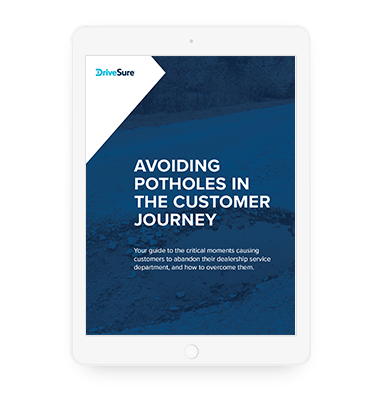With so many changes and disruptions in the automotive industry, it’s no longer enough to simply provide excellent service. Staying ahead of the competition these days requires having an edge, and this is especially true in the service lane.
This explains why more dealerships are learning to lean on data analytics to drive decisions, and to optimize dealership performance. When you leverage your dealership’s analytics effectively, you can improve customer satisfaction, make your operations more efficient (from assigning tasks to managing inventory), and get better results from your marketing strategies.
But what does that actually look like? How can your dealership’s service department benefit from becoming more data-focused? What kind of metrics should you track? Let’s get started.
Understanding the Importance of Data Analytics in the Service Department
Data analysis allows service departments to rely more on facts than subjective judgment, to help improve various aspects of dealership operations. Dealers leveraging data analytics can:
Enhance customer experience
Improving customer experience is essential for increasing profitability in the service department. By reviewing data to determine peak service hours for instance, dealerships can adjust staffing levels accordingly to reduce wait times and improve overall customer satisfaction. Data analytics can also be used to:
- Analyze customer behavior: For example, a dealership might discover that their clients prefer receiving text message updates about their vehicle’s service status, leading the dealership to implement a more efficient text-based communication system.
- Streamline appointment setting: By recognizing that most customers call to schedule appointments during weekday lunch hours, a dealership could adjust staff schedules to ensure sufficient coverage during these peak times, reducing customer wait times on the phone.
- Enhance communication: If a dealership identifies that a high percentage of inbound calls are related to status updates, they could implement a proactive communication plan. For instance, sending automated service progress updates to customers, which reduces the volume of inbound calls and increases customer satisfaction.
Prepare for the 5 make-or-break moments that can cause service customers to start going elsewhere.
Optimize service department operations
By analyzing technician performance data, dealerships can identify skill gaps and provide targeted training, ultimately increasing productivity and service quality. Identifying skill gaps can also help improve service lane capacity without having to construct anything new: if you have experienced technicians and newbie, the newbies will take longer to complete complicated repairs, so assigning them simpler jobs like oil changes helps you get the complicated jobs done faster.
Analyzing call data and appointment schedules can also help dealerships identify optimal staffing levels, ensuring that service advisors and technicians are not overworked, and that customers receive prompt service.
Manage inventory:
Inventory shortages can hurt, but they can often be easier to manage when you can get your orders in before you need them. When looking at historical service jobs, dealerships can make better decisions about which parts to stock in their inventory, ensuring they meet customer demands and get vehicles serviced, with less time waiting around for replacement parts.
- Anticipating seasonal demand: Say you notice the data shows an increase in demand for tire replacements during certain winter months. By stocking up on an appropriate amount of winter tires ahead of time, the dealership can be prepared for the seasonal rush and reduce wait times for customers.
- Identifying commonly replaced parts: You probably have a good sense for which parts are most frequently replaced during routine maintenance (such as brake pads, air filters, and oil filters), but having good data accessible will help also show how often you typically restock for each part, making stock orders easier to automate.
- Stocking parts for popular vehicle models: By reviewing data on the most serviced vehicle makes and models, dealerships can ensure they have the right parts in stock for their customers’ vehicles. This not only helps to reduce the time it takes to complete a service job but also demonstrates your dealership’s commitment to providing efficient, tailored service for their clients.
Tracking the right metrics to grow service revenue
To successfully leverage data analytics in the service department, dealerships must first identify the key performance indicators (KPIs) that directly impact their profitability. Consider using KPIs such as:
- Customer Satisfaction Index (CSI) scores: High CSI scores indicate a positive customer experience, which can lead to increased customer loyalty and repeat business.
- Call fail rate: A low call fail rate demonstrates that the service department is efficiently handling customer inquiries and booking appointments.
- Defection rate: Tracking the number of customers who switch to competitors helps dealerships identify areas for improvement and implement strategies to retain clients .
- Relative price of services: By monitoring prices relative to competitors, dealerships can ensure their service pricing remains optimal, balancing profit margins with total customer volume.
- Revenue growth: Monitoring overall revenue growth is crucial to assess the department’s financial health and identify potential growth opportunities.
- Campaign conversion rate: By tracking the conversion rate of personalized marketing campaigns , dealerships can measure the effectiveness of their targeted efforts to drive service appointments.
Understanding your customers for better marketing communication
By having key customer data on hand, preferably linked up with an automated maintenance marketing system , you can provide more personalized communication and drive better results. Make sure you’re logging data points such as:
- Vehicle make and model: Knowing the type of vehicle a customer owns can help a dealership tailor marketing messages to that customer’s specific needs, such as suggesting maintenance services or highlighting new models that may be of interest.
- Purchase history: Understanding a customer’s past purchases, such as the type of vehicle they bought and when they bought it, can help dealerships anticipate when a customer may be in the market for a new car or in need of service.
- Service history: Tracking a customer’s service history can help a dealership anticipate what services a customer may need in the future and target them with relevant offers.
- Demographic information: Knowing a customer’s age, income, and other demographic information can help dealerships tailor their marketing messages to resonate with that customer’s specific needs and interests.
- Communication preferences: Understanding how a customer prefers to be contacted, whether it’s via email, text message, or phone call, can help dealerships reach out to customers in a way that’s convenient and comfortable for them.
Overcoming Obstacles in Implementing Data Analytics
While data analytics offers numerous benefits, dealerships may encounter some challenges in implementing these tools. Some of these are easier to overcome than others:
- Data quality: Dealerships sometimes struggle with collecting and maintaining accurate, up-to-date data. Ensure data collection methods are standardized, implement data cleansing practices, and conduct regular data audits.
- Integration issues: Any business will struggle to integrate data from multiple systems and platforms. To handle this, you may want to consider using a cloud-based data management system that can integrate data from other systems, like your DMS or accounting software.
- Skill gaps: Depending on the system you choose, more technical expertise might be needed. You can consider upskilling current employees if that’s the case, hire external specialists, or simply look for a system that’s user friendly.
- Cost: Dealerships may find implementing data analytics systems expensive. Data systems are only as good as the processes you’re using to track and leverage your data, so if you’re considering a major upgrade, make sure you have a clear plan for how the insights generated by your system will be used to improve results.
Your DMS may have some built-in data analytics capabilities, but in many cases these are limited. To fully harness the power of data analytics in your service department, you may need to consider investing in specialized data analytics software or supplementing your DMS with a customer relationship management system (CRM), or other third-party analytics solution that offers features like customizable reporting.
We won’t endorse any particular solution here, but this list of dealer CRMs has many options to choose from. By leveraging your dealership’s analytics, you have the potential to significantly increase profitability in the service department. Having access to valuable data can make a huge difference in growing your profitability.
For instance, knowing when service customers are most likely to defect can help you be proactive about maintaining their loyalty. To learn more about these critical moments, read our guide to Avoiding Potholes in the Customer Journey.
Master These Moments to Keep Your Customers
Discover the 5 critical moments causing customers to abandon your dealership service department, and how you can overcome them.


